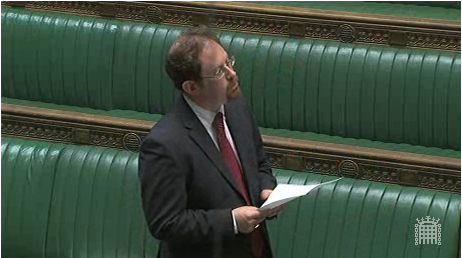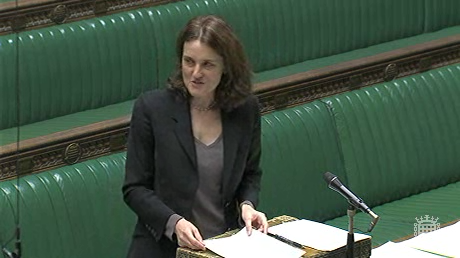
Friday 21st January 2011 saw a short Adjournment Debate in the House of Commons on the subject of "Cycling in England". A question was raised as to the government's support for use of tax money (£2.4 million) on the TransportDirect cycle journey planner when CycleStreets (£28.1k spent) already exists.
This debate on cycling was secured by Julian Huppert MP, a long-standing supporter of cycling. His excellent speech covered a range of issues – many of which are raised by contributors to our Photomap – such as the issue of poor signing of contraflow streets, parking in cycle lanes and pavement parking, lack of cycle parking at stations and much more.
The MP ended his speech with this question:
"If I may finish on a suitably austere note: Other cycling enthusiasts have noticed, that the Government, in its Sustainable Transport White Paper, plans to spend more money on developing its own cycle journey planner. In the spirit, perhaps of the Big Society, could I point the Minister and her Department to the CycleStreets website, which already provides such a service, reliably and efficiently, and without requiring millions of pounds of government subsidy. The website was developed by two of my constituents, both avid cyclists, very much involved with the excellent Cambridge Cycling Campaign, and it cost a total of around £40,000 to cover the whole country. I hope the minister will consider the value for money of supporting and utilising their work, rather than inventing a new wheel. I look forward to her comments. Thank you."
— Julian Huppert MP
The Minister of State for Transport, Theresa Villiers MP responded, towards the end of her speech:
"My Honourable Friend for Cambridge concluded his remarks by expressing a degree of concern about the DfT developing its own cycle journey planner when websites, very good websites like CycleStreets, are already available. Well, I think, given the importance of this issue there is room for government action in this area to complement the websites provided by the private sector, particularly with our focus on giving novice cyclists the information they need to encourage them to go out cycling, so they've got the confidence that they can identify, able to identify, the easier and the safer routes."
— Theresa Villiers MP
[Actually, only £28.1k has been spent (compared to £2.4m allocated to TransportDirect) and of course the project depends on the excellent work of OpenStreetMap mappers. Also note that CycleStreets is a not-for-profit project.]
You can watch video of these two speeches online:
Screenshots from www.parliamentlive.tv

3 thoughts to “CycleStreets discussed in Parliament”
Pingback: Tweets that mention CycleStreets » Blog -- Topsy.com
Some time back the 'Power of Informtation Report' recommended a number of actions by government, some of which have been actioned and some of which have not. I have quoted the most relevant ones to this issue below as a reminder with my highlights. Recommendations 1,2 and 3 relate specifically to this situation and I can't see how the department can justify continuing to compete with voluntary effort in this way – far from 'terminating services that are no longer required' they are pumping more money into them. Recommendations 4 and 5 have of course been exceeded – with the Open Governement License allowing commercial reuse and the opening up of raw OS data for reuse.
Recommendation 1. To improve service delivery and communication with the public, the Central Office of Information (COI), in partnership with the Office of Public Sector Information (OPSI), should coordinate the development of experimental partnerships between major departments and user-generated sites in key policy areas including parenting advice (Department for Children, Schools and Families (DCSF)), services for young people, and healthcare (Department of Health (DH)).
Recommendation 2. To reduce unnecessary duplication of pre-existing user-generated sites, COI should update the guidelines for minimum website standards by December 2007; departments should be strongly advised to consult the operators and users of pre-existing user-generated sites before they build their own versions.
Recommendation 3. Departments, monitored by COI, should research the scale and role of user-generated websites in their areas, with a view to either terminating government services that are no longer required, or modifying them to complement citizen-led endeavours.
Recommendation 4. To encourage innovation in the re-use of information by non-commercial users, UK trading funds should, in consultation with OPSI, examine the introduction of non-commercial re-use licences, along the lines of those pioneered by the BBC’s Backstage project and Google Maps.
Recommendation 5. To promote innovation, Ordnance Survey should, by the end of December 2007, launch its Open Space project to allow non-commercial experimentation with mapping data.
I can't help comparing the number of people in the Commons to hear that debate (I saw 3 people excluding the speaker and some others who were probably recording the proceedings) with the number of people actively contributing to OpenStreetMap during the day in question.
The zip file for changes to OpenStreetMap on that day runs to 45Megabytes and this include 150 edit sessions relating to the South of England – the first edit in that area was made 4 minutes after midnight and the last was made at 1 minute to midnight! Edits made in the North of England are not immediately available to me but are no doubt similar in scale. OpenStreetMap now also has the support of Microsoft and AOL (via Bing Maps and MapQuest respectively) who are pumping resources into the project and we also the release of OS data for reuse. The combination of Bing's Aerial photography and the OS Streetview/OS Locator makes it much easier to add content to the database for the benefit of CycleStreets. Do check out the progress of OpenStreetMap converage using ITO's new OSM Analysis service which reports of progress daily with a thematic map showing quality across the country. As of today 68% of UK named roads are in the OSM DB with 140,000 addded in the past 9 months. Details here:
http://itoworld.blogspot.com/2011/01/openstreetmap-gb-progress-report.html
Given all of the above it is clear to me that the DfT would benefit greatly by following the recommendations of the PoI report and support rather than complete with CycleStreets. In this case I am confident that in time the DfT cycle planner will fade away in time the face of low usage and any money spent on it will be wasted. I will continue to enourage the DfT to adjust its approach!
Full text,
http://www.theyworkforyou.com/debates/?id=2011-01-21a.1199.0&s=speaker%3A24892#g1199.2